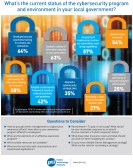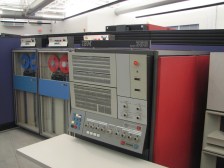Why NASTD’s mainframe survey warrants a closer look

This summer, the National Association of State Technology Directors released survey results indicating a rather bleak future for the mainframe in state government IT. News coverage seemed to imply that state IT teams couldn’t migrate off the platform fast enough. But before IT leaders consider this as just the latest validation to abandon their mainframes, they’d be well advised to take a closer look.
The survey does make valid points — for example, a prevalent desire to move to a hybrid approach, using in-house mainframes along with cloud-based infrastructures — but it fails to make several important distinctions, leading to some overly generalized conclusions that contradict industry facts.
For example, the survey suggest a low level of future demand for mainframe computing power, while other new research clearly shows the opposite. In BMC’s just-released State of the Mainframe 2018 survey, 92 percent of respondents reported strong views of the mainframe as a long-term platform.
And while certain attitudes toward the mainframe may be justifiable, they are in stark contrast with reality and may not be the best compass for government IT teams looking to chart the right way forward.
The first ambiguity: Who exactly are the respondents?
We don’t really know who responded to NASTD’s survey, except that they are IT leaders at state agencies who interact with the mainframe in some capacity. But are these respondents mainframe hardware administrators, mainframe developers, or a mix of both? This lack of clarity is problematic because these are two very different job functions with differing challenges and prerogatives.
If the respondents were mostly hardware administrators, we’re not surprised at the results. For example, 61 percent noted they are “looking to either entirely outsource the management of their mainframe hardware systems. This result is in line with trends we’re seeing across both business and government spending, where IT organizations are increasingly outsourcing routine functions, such as hardware maintenance, to focus on more strategic goals.
However, other survey questions, which seem more geared toward developers, seem to tell a very different story. Question 19 asks, “If using or pursuing MFaaS, who would maintain the software licenses and maintenance?” The largest category of respondents, 39 percent, said the state would take on maintenance, suggesting a reticence to entrust ownership and responsibility for mainframe software outside of one’s own walls.
This is likely for good reason, since mainframe software code tends to support the most mission-critical applications, and code innovation overall is the key to supporting and delivering modern online citizen services.
Thus, by failing to clearly distinguish between mainframe hardware and developer respondents, the survey results paint a fuzzy, over-generalized picture about prevailing attitudes.
The second ambiguity: What exactly is meant by “mainframe application”?
Are we talking about an application that is totally based on the mainframe, like a batch-processing database? Or are we discussing a multi-platform transactional application that may initiate on a front-end web server and traverse multiple servers before landing on a mainframe for completion? This is another critical distinction the survey does not make, because while the number of completely self-contained applications and databases running on the mainframe may be shrinking, quite the opposite is happening with the transaction-processing component (i.e., the mainframe’s core competency) of modern applications.
The NASTD survey found that 47 percent of respondents — the largest category — are not considering growing their mainframe applications portfolio. Assuming we are talking about a completely mainframe-based application, this is not surprising. Many digital services that are not mission-critical in nature do not require the superior levels of availability, security and scalability the mainframe delivers, and there are other ways (like the cloud) to support them.
But the mission-critical transaction-processing component of modern applications is a different story. BMC’s recent survey found that 59 percent of mainframe users are seeing an increase in transaction volumes. This is driven largely by the mobile explosion, and the mainframe is the ideal platform — and in fact the only platform — that can deliver the levels of performance these transactions require, combined with tremendous cost efficiencies.
Other research has found mainframes to be much more cost-effective over the long term than commodity servers because reductions in commodity server pricing have not kept pace with exploding mobile transaction volumes. Rubin Research recently compared two banks — one a mainframe user and the other a commodity server user — and both banks saw their need for computing power double over a five-year period. However, the mainframe user experienced a 30 percent increase in core infrastructure costs, while the commodity server user witnessed a 49 percent cost increase.
Much like the ambiguity around respondents’ roles, the lack of clarity regarding application type also calls the survey results into question, as they may not accurately reflect the mainframe’s vital role in supporting state agencies’ applications, which is not just entrenched but growing. The mainframe is not for everything, but it is ideal, secure and cost-efficient for what it does (transaction processing), which is why — as the survey found — mainframes have stuck around.
Negative attitudes
Looking beyond these ambiguities, the comments made by survey respondents indicate a level of frustration. Whether the survey respondents were in hardware or software, we’re not surprised, as we’ve been talking about this for a long time, particularly from the developer perspective. These negative feelings are a sign the status quo is not working, and something needs to change, particularly if a state agency wants to offer convenient, “citizens first” applications that deliver exceptional experiences with minimal costs.
But outsourcing mainframe development or moving to traditionally mainframe-based work to another platform isn’t the answer. Rarely do projects of this size and scope succeed, as numerous examples demonstrate. At best, you are doling out millions of dollars migrating to system that is not only less performant, but costlier in the long run. The worse scenario is wasting time and resources and assuming great risk, only to ultimately backpedal. Is this really the best use of taxpayer dollars?
The optimal approach, borne out by large organizations in the private sector, is to focus not on moving, but instead on updating your mainframe development initiatives and fully integrating them into a modern, cross-platform software development environment. This is the key to retaining the mainframe’s benefits without compromising developer productivity. This will empower developers to innovate and create the next generation of transactional online citizen services.
If you are a developer working in state IT on the mainframe, we don’t doubt that you’re frustrated. But the survey results, while valid in some aspects, have been cast in a manner that may not truly reflect your peers’ attitudes. Furthermore, the conclusion that mainframe applications are shrinking in number — and reliance on the platform will inevitably shrink as a result — is also based on a shaky foundation.
Our advice when you encounter surveys like this? Hear and understand the message, but also be wary of peer pressure, dig below the surface, know the facts and look to the private sector’s experience with various alternatives — before you decide on your next move.






